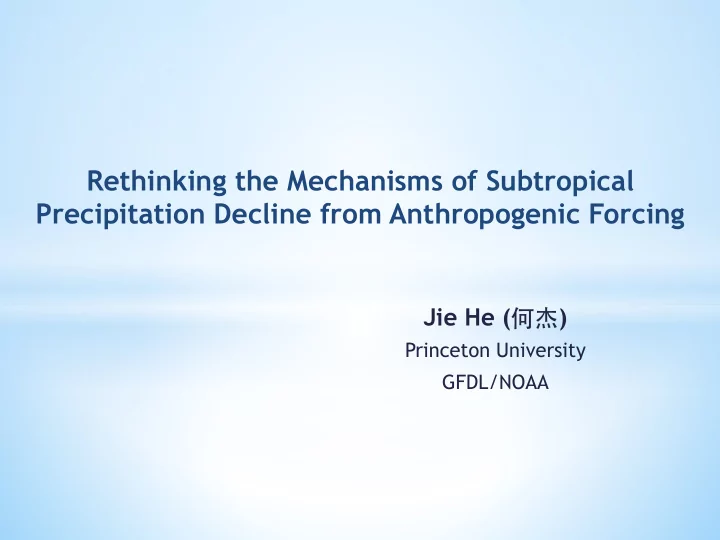

Rethinking the Mechanisms of Subtropical Precipitation Decline from Anthropogenic Forcing Jie He ( 何杰 ) Princeton University GFDL/NOAA
Precipitation declines in the subtropics. • Model evidence (1pctCO2, mm/day/K) • Observation (Neelin et al. 2006 PNAS; Dai 2012 Nature CC; Chadwick et al. 2015 Nature CC) Introduction Method Results
Why do we care? “If these models are correct, the levels of aridity of the recent multi-year drought or the Dust Bowl and the 1950s droughts will become the new climatology of the American Southwest within a time frame of years to decades.” -- Seager et al. 2007, Science Introduction Method Results
Why do we care? • California Drought (2011-2015) • Australia Drought (1997-2009) Introduction Method Results
Why less rainfall in the subtropics? 2 prominent mechanisms: • “Dry-get-dryer” • Poleward shift Introduction Method Results
Why less rainfall in the subtropics? • “Dry-get-dryer” (Held and Soden 2006, J. Climate ) ∫ P − E = − ∇⋅ ( q ⋅ V ) ∫ δ ( P − E ) = − ∇⋅ δ ( q ⋅ V ) ∫ ∫ ∫ δ ( P − E ) = − ∇⋅ ( δ q ⋅ V ) ∇⋅ ( q ⋅ δ V ) ∇⋅ ( δ q ⋅ δ V ) − − ∂ q δ V ≈ 0 q = 7% / K ∫ δ ( P − E ) = − ∇⋅ ( δ q ⋅ V ) Clausius-Clapeyron δ q ≈ q × 7% / K ∫ δ ( P − E ) = − ∇⋅ ( q ⋅ V ) × 7% / K = ( P − E ) × 7% / K Introduction Method Results
Why less rainfall in the subtropics? • “Dry-get-dryer” (Held and Soden 2006, J. Climate ) δ ( P − E ) = ( P − E ) × 7% / K Climatological (P-E)x7%/K Change in P-E δ P ≈ ( P − E ) × 7% / K Introduction Method Results
Why less rainfall in the subtropics? • “Dry-get-dryer” (Held and Soden 2006, J. Climate ) Subtropical precipitation decline Increased moisture export Increase in moisture Global mean warming (a thermodynamic response) Introduction Method Results
Why less rainfall in the subtropics? • Poleward shift (Scheff and Frierson 2012, J. Climate ) Change in zonal mean stream function (kg/s/K) Global mean warming (He and Soden 2015, J. Climate ) Introduction Method Results
A new perspective… • “Dry-get-dryer” Mean SST warming • Poleward shift Increasing CO 2 Atmospheric Land-sea warming contrast model SST warming Mean SST warming Pattern of SST change Introduction Method Results
A new perspective… Abrupt4xCO2 (14 CGCMs, CMIP5) Direct CO 2 forcing Fast Land-sea warming contrast Pattern of SST change Mean SST warming Slow Introduction Method Results
Fast VS Slow responses “Dry-get-dryer” Poleward shift Fast precipitation decline • Neither “Dry-get-dryer” nor poleward shift is not required for the subtropical precipitation decline. • Neither of the two mechanisms contributes to the subtropical precipitation decline. Introduction Method Results
A more realistic scenario… Total Change (1pctCO2) AMIP_CO 2 AMIP_mean AMIP_pattern Mean SST warming only Pattern of SST change only CO 2 + land-sea contrast Introduction Method Results
A more realistic scenario… Subtropical precipitation decline does not depend on the global mean SST • warming. Introduction Method Results
A more realistic scenario… “Dry-get-dryer” & poleward shift Direct CO 2 forcing Land-sea warming contrast Introduction Method Results
Direct CO 2 VS Land-sea contrast δ P in AMIP_CO2 Stabilization (Bony et al. 2013, Nature CC) or Land-sea? ∫ ∫ ∫ δ ( P − E ) = − ∇⋅ ( δ q ⋅ V ) ∇⋅ ( q ⋅ δ V ) ∇⋅ ( δ q ⋅ δ V ) − − Thermodynamic change Dynamic change ∫ ∫ δ P = − ∇⋅ ( δ q ⋅ V ) ∇⋅ ( q ⋅ δ V ) + δ E + R − Evaporation change Eddy transport
Direct CO 2 VS Land-sea contrast • Land-sea contrast drives convection change. • Direct CO 2 forcing reduces evaporation (He and Soden 2015, J. Climate ) . Introduction Method Results
Summary * Conventional wisdom: “dry-get-dryer” and poleward shift. * Subtropical precipitation decline is primarily a fast response and does not depend on the global mean SST warming. * The large-scale subtropical precipitation decline is driven by the direct CO 2 forcing and land-sea warming contrast and, in certain regions, pattern of SST change.
References Chadwick, R., P . Good, G. Martin, and D. P . Rowell, 2015: Large rainfall changes consistently projected over substantial areas of tropical land. Nat. Clim Change , advance online publication . http://dx.doi.org/10.1038/ nclimate2805. Dai, A., 2013: Increasing drought under global warming in observations and models. Nat. Clim Change , 3 , 52– 58, doi:10.1038/nclimate1633. He, J., and B. J. Soden, 2015: Anthropogenic Weakening of the Tropical Circulation: The Relative Roles of Direct CO2 Forcing and Sea Surface Temperature Change. J. Clim. , 28 , 8728–8742, doi:10.1175/JCLI- D-15-0205.1. Held, I. M., and B. J. Soden, 2006: Robust responses of the hydrological cycle to global warming. J. Clim. , 19 , 5686–5699, doi:10.1175/JCLI3990.1. Neelin, J. D., M. Münnich, H. Su, J. E. Meyerson, and C. E. Holloway, 2006: Tropical drying trends in global warming models and observations. Proc. Natl. Acad. Sci. , 103 , 6110–6115, doi:10.1073/pnas.0601798103. Scheff, J., and D. Frierson, 2012: Twenty-first-century multimodel subtropical precipitation declines are mostly midlatitude shifts. J. Clim. , 25 , 4330–4347, doi:10.1175/JCLI-D-11-00393.1. Seager, R., and Coauthors, 2007: Model projections of an imminent transition to a more arid climate in southwestern North America. Science , 316 , 1181–1184, doi:10.1126/science.1139601. Questions?
Recommend
More recommend